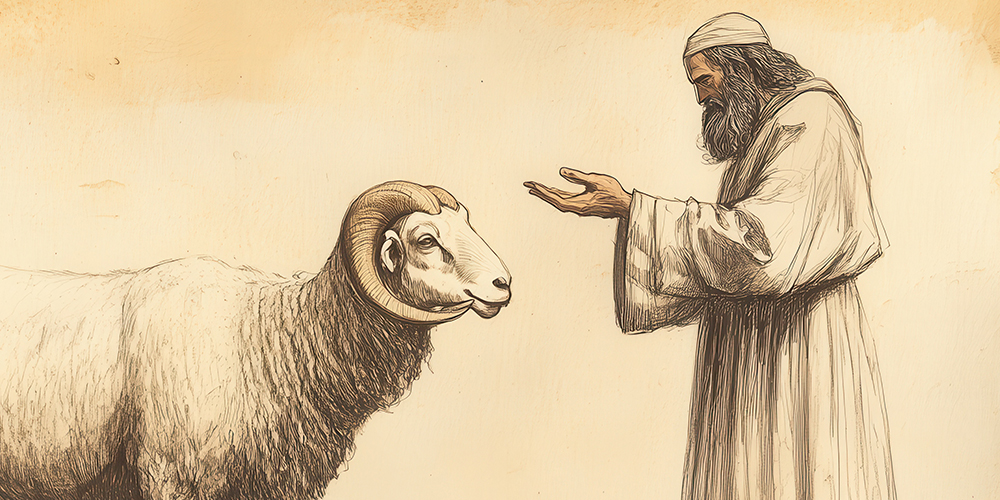The trespass offering is the final Levitical sacrifice required of an Israelite. This offering illustrates the primary aspect of the work of the cross. The Hebrew word for trespass is “asham,” meaning guilt. It addresses the question of how a man may be forgiven for the consequences of their sins, for every sin is an offense against the God of the universe. The trespass offering occupies the section from Leviticus 5:14 through chapter 6:7.
The Trespasser’s Sins
There were two aspects in which a man might commit a trespass: it could be against God (5:14-19) or because of something done to a neighbor (although still against the Lord, 6:2). Thus, both portions of the moral law could be violated—toward God and toward one’s neighbor. A trespass may be against a fellow man; nevertheless, it is a sin primarily against God.
David trespassed against his soldier-friend, Uriah the Hittite, against Bathsheba herself, and even against all Israel. Yet in his prayer of confession (Ps. 51), he cried out from the depths of an anguished heart, “Against Thee, and Thee only, have I sinned, and done this evil in thy sight…” (v.4).
The Trespasser’s Offering
A notable difference from the sin offering is that, in the case of the trespass offering, there was only one type of animal sacrifice. Whether the trespass was against God in the holy things or against His law, or a trespass against God in their relationship with others, a ram was brought in each case. The trespass offering was an acknowledgment that they had failed to give God and man what was due to each. In this way, they had not only trespassed and “gone beyond” what they should have done, but had also fallen short of God’s standard.
The ram is closely associated with consecration, as seen in Genesis 22 and Exodus 29. Each ram offered as a trespass offering reminded the offender that they had failed to do God’s will and pleasure, having satisfied their own desires in some way and thus committed a trespass. The Lord Jesus, in His complete consecration to God, never failed to give both God and man their full due. Fully yielded to the will of God, He did not sin either in the holy things, nor in matters concerning others. Lewis Sperry Chafer (1871–1953), founder of Dallas Theological Seminary, tells us of the results of being devoted to God. He writes:
“One result of the act of remembering the Lord’s death in the breaking of the bread is the deepening of the personal consciousness of the meaning and value of that death. It is noticeable that those Christians who are frequently exercised in spirit towards his death in the breaking of the bread are the most awake concerning the value of the sacrifice of Christ for them. The disciples met on the first day of the week to break bread (Acts 20:7). They knew the real desire of the Lord for them in this important matter and they knew the value of this ordinance in their own lives. A child of God should always be increasing in heart appreciation of his Savior’s finished work.”1
The Trespasser’s Restoration
This offering teaches us that God is vitally interested in relationships. He covets the relationship He has with His people, and He desires that we maintain right relationships with one another. Sin mars all of this. Trespasses undermine these right relationships. Nevertheless, our God is in the restoration business, and He begins by repairing the relationship between God and man. The sacrifice provided, prefigured in the ram of consecration, becomes the means of reconciliation for a right relationship with God. We are reminded of the words from Psalm 69:4: “…Then I restored that which I took not away.” The Lord Jesus had no part in the entrance of sin into our world. The soiling of that pristine and blessed relationship between God and man was marred by the awful reality of sin. Christ did not “take it away;” on the contrary, He restored it. Thus it is that we are “reconciled to God by the death of His Son” (Rom. 5:10). The trusted Bible expositor H. A. Ironside (1876-1951), concerning this work of Christ has written,
“What the sacrifices of old could not accomplish, namely, the actual putting away of sin, has been accomplished through the finished work of our Lord Jesus, that one offering, never to be repeated, which He made on our behalf upon the accursed tree. We cannot add to this finished work and thank God we cannot take away from it. It stands alone in marvelous completeness. In Christ’s sacrifice God has found infinite satisfaction too.”2
Additionally, God is vitally interested in the relationships among believers. In His triune nature, He has dwelt eternally in a relationship. He created us to enjoy relationships and having been reconciled to God and brought into the family of God, we are to maintain relationships based on righteousness and love.
The Trespass Offering as a Picture of Christ
God always does “exceedingly abundantly above all that we ask or think.” Figuratively, the trespass offering pictures the “exceeding abundant” work of Christ by which He restored that which He took not away (Ps. 69:4b). Isaiah the prophet presents this same aspect of the Messiah’s work when he writes, “Yet it pleased the Lord to bruise Him; he hath put him to grief: when thou shall make his soul an offering for sin…” (Isa. 53:10). The word for offering is asham (guilt), the same word used for the trespass offering. Christ was our trespass offering when He offered himself “exceedingly” on the cross of Calvary for our sins. Our Savior provided the required sacrifice needed to satisfy God and, in so doing, to reconcile man to Himself.
Christ’s substitutionary work in the New Testament is a description of the trespass offering. First, Christ came “…to give his life a ransom for many” (Matt. 20:28). The preposition “for” means Christ died in the place of, or instead of the sinner. Second, “For Christ also hath once suffered for sins, the just for the unjust, that he might bring us to God…” (1 Pet. 3:18). Here, the word “for” literally means on behalf of or for the benefit of, indicating that Christ suffered and died not only in the sinner’s place, but for the sinner in bringing him to God.
Conclusion
The trespass offering was to be killed at the altar and its blood sprinkled around the altar. Certain parts of the offering were burned upon the altar as an expression of divine judgment against the guilty one’s sin, while other parts were eaten by the priests in the holy place. The priest of old would feed on the trespass offering.
Every believer is a priest today, and it is the holy responsibility of each of us to spiritually feed upon our Savior, the true trespass offering. We do this as we read the Word of God and meditate upon what it reveals concerning the atoning work of our Lord Jesus Christ. Through this work He put away all our sins and trespasses and made us fit for the presence of a holy God. May we diligently seek to meditate on and consider the benefits of Christ’s death for each of us.
ENDNOTES
1. Lewis Sperry Chafer He That Is Spiritual, (Grand Rapids, MI: Zondervan, 1918), p.119
2. H. A. Ironside, Lectures on the Levitical Offering, (New York: Loizeaux Brothers, 1979), p.77

